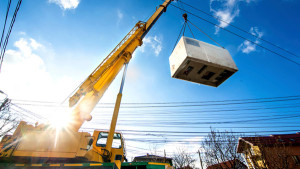 Treat no crane lift as routine.
Treat no crane lift as routine.
The world of construction is fast paced. Contractors strive to complete their projects quickly and efficiently without sacrificing quality or safety. Mobile cranes are versatile and powerful pieces of equipment that can help contractors reach those goals by moving materials and equipment great distances and placing them in hard-to-reach areas.
Whether a contracting firm owns or rents a crane or has a crane present on its jobsite, no lift should be treated as routine. There is always potential for death, injury, property damage, interruption of business and the effects of bad publicity.
Accident risk is present from the time the crane leaves the storage yard to the time the job is over – and at every stage in between: in transit, during assembly and setup, during use and throughout disassembly.
Avoid crane accidents and complete lifts without incident by adhering to recognized best practices:
BEFORE A LIFT
- Carefully plan all anticipated lifts before construction begins, taking into account weight of loads, maximum height of lifts and maximum radius of lifts. Consider using a crane scale.
- Properly train and qualify riggers to ensure they can calculate safe rigging loads.
- Thoroughly evaluate the site to assure or make preparations for adequate ground support. Engineered site work may be needed.
- Follow regulatory and manufacturer requirements for regular inspections and make any needed repairs.
- Obtain a copy of the annual and most recent monthly inspections for nonowned cranes prior to permitting them on your jobsite.
- Ensure that contract stipulations and insurance coverages for nonowned cranes are reviewed by qualified legal counsel.
- Understand the manufacturer’s notes for lifting capacity deductions such as concrete bucket use, clamshell use and wind effects.
- Plan for and procure the quality and quantity of blocking, cribbing and fabricated mats necessary to achieve adequate ground support.
- Determine Stop Work conditions such as wind, changing ground conditions and other hazards.
DURING USE
TROUBLESHOOTING
- Perform manufacturer-specified maintenance and inspections, including warning and safety devices/sensors. Report all defects and wear.
- Thoroughly inspect all rigging/lifting devices and related hardware per manufacturer instructions.
- Immediately disable or red tag damaged, defective or worn rigging. Do not allow “homemade” or nonengineered rigging to be used.
- Stay ahead of weather conditions that could result in Stop Work.
Cranes are engineering marvels capable of performing incredible lifts. But each crane has limitations. The key to preventing accidents with cranes lies in knowing and respecting those limitations, planning carefully, and having the courage to stop work and adjust the plan whenever necessary.
This loss control information is advisory only. The author assumes no responsibility for management or control of loss control activities. Not all exposures are identified in this article.